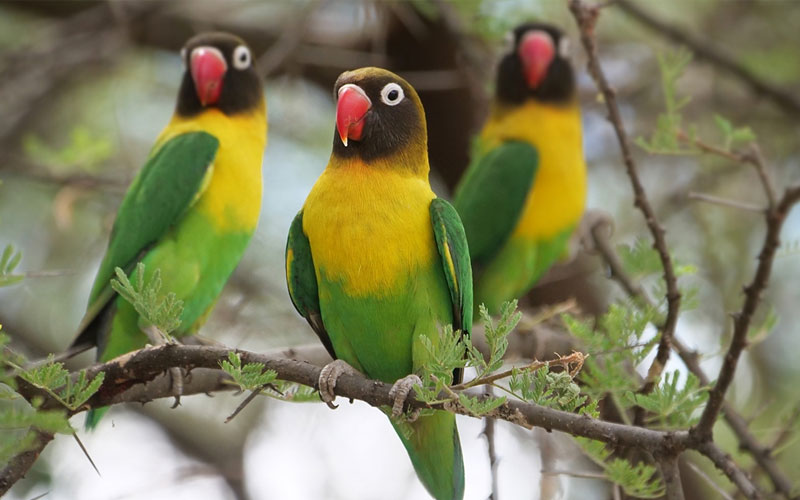With their vibrant plumage and affectionate nature, lovebirds make fantastic companions for pet enthusiasts seeking feathered friends.
Species
Lovebirds come in many species and colors, but peach-faced and Fischer’s lovebirds are the most popular for sale as pets. These two are available as wild-caught and hand-raised youngsters require frequent handling to stay tame. It is best to purchase a young bird rather than an adult since these are easier to train. Adults may become aggressive, primarily if they are handled infrequently. These birds are active and intelligent, so they learn quickly and develop a strong bond with their owners, provided that enough interaction is given to them. This is why they are best kept in pairs or with a sibling instead of alone, which can cause them to depress and self-mutilate.
When training a lovebird, it is essential to take things slowly and not get frustrated with the bird. Doing so can cause the bird to become fearful and lash out at its cagemates or humans. If this happens, a professional avian veterinarian should be called immediately because the bird is likely to have a contagious illness like Chlamydia psittaci (parrot fever), which causes appetite and weight loss, wet droppings, lethargy, nasal discharges, and other symptoms. A lovebird’s habitat should have a large, spacious enclosure with several perches and four sturdy dishes for water, food, pellet/ seed mix, and a bath dish. This cage type should also have a secure door and a sturdy perch to hang toys. Avoid toys with small parts that can be chewed off and ingested.
Care
Lovebirds are active, playful birds that will do well in a family. They can be feisty, and they are incredibly bold for their size. They are parrots in little parrot bodies. They will do best in a mated pair but can be kept alone if they get lots of interaction and human attention. Lovebirds can be hand-tamed, but it takes time and patience. It is best to start with a young, hand-raised bird. It is also best to choose a healthy bird, as one that looks stressed or unhappy may exhibit aggressive behavior. A healthy lovebird should be bright and alert with no scabs or rough spots on the skin. It should also have a clean cage, fresh food and water, and a comfortable perch. It should be free of any odors, especially smoke and strong smells. Choosing lovebirds for sale from a reputable seller ensures the health and well-being of your feathered companions. It provides valuable insights and guidance on their care, making the journey of pet ownership a delightful and informed experience. Reputable sellers prioritize the welfare of their lovebirds, offering beautiful and well-socialized birds and a trusted source for ongoing support, creating a foundation for a rewarding and lasting relationship with your avian friends.
Personality
Lovebirds are sweet and intelligent, making them endearing companions. However, they can also be stubborn and complex if they are not tamed at a young age. It is best to purchase a lovebird from a breeder to ensure it has been socialized with people and other birds. This makes it less likely that your pet will nip or bite. This species is named for the solid and monogamous pair bonds it typically forms with a chosen mate. These relationships can last for years. In the wild, lovebirds rest in tree branches, cacti, and small, covered “beds.” You can mimic these behaviors by placing a soft willow or oak branch in a favorite spot to serve as a bed. Covering the cage at night so your lovebird can sleep peacefully is also a good idea. Though not as loud as some parrots, lovebirds can produce high-pitched screech when they want to be noticed. They also like to chatter, chirp, and squawk. A comfortable environment will make them more content and willing to bond with you. Showering them with affection and attention will help to ensure this happens. You can even train them to go potty on command, rewarding this positive behavior with treats and affection.
Feeding
Lovebirds are primarily seed-eating species. However, it is essential to supplement this seed mix with safe vegetables and fruits. These include berries, bananas, apples, pears, and kiwi. These foods are also a great source of vitamins and minerals. In addition, fresh thyme and parsley can be added to the diet for extra flavor. These birds are active and need an appropriately sized cage filled with toys to chew, play, and explore. Without social interaction, a large cage, and plenty of toys, these feisty birds can become neurotic and self-mutilate. As part of their normal behavior, lovebirds like to climb and chew. They may chew furniture and electrical wires if they need to be provided with more things to entertain them. To prevent this, it is wise to provide them with plenty of safe wood and sisal toys and a variety of household items that are safe for them to chew on, such as paper towel tubes, ink-free cardboard, acrylic, and leather. Lovebirds are not typically considered good talkers, but they do tend to form strong bonds with their owners and can learn a few words. It is also possible to tame these birds through acceptance and consistent handling. You can begin by letting your bird get comfortable with you and offering treats on your finger. Eventually, you can replace your finger with a dowel and get the bird to step onto it.













